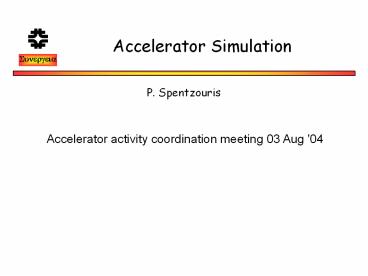Accelerator Simulation - PowerPoint PPT Presentation
1 / 17
Title:
Accelerator Simulation
Description:
Accelerator Simulation P. Spentzouris Accelerator activity coordination meeting 03 Aug '04 – PowerPoint PPT presentation
Number of Views:87
Avg rating:3.0/5.0
Title: Accelerator Simulation
1
Accelerator Simulation
- P. Spentzouris
Accelerator activity coordination meeting 03 Aug
'04
2
Accelerator modeling activities
- Note I did not say projects...
- SciDAC accelerator modeling project
- Booster beam studies
- analysis tools analysis
- MCR optics software
- contributors J.Amundson P.Spentzouris
http//cepa.fnal.gov/psm/aas/Advanced_Accelerator_
Simulation.html
3
SciDAC Accel. Modeling Project
- What we have accomplished
- the first 3 years of SciDAC
- What we would like to accomplish (baseline)
- the next 2 years setting up future projects
- Opportunities (additional manpower)
- developing the foundation for a long term
program. Investing now for a larger return later!
4
Multi-institution collaboration, 3M/3 years,
FNAL 0.32M/3years 2 year extension, 30
bump up for FNAL, flat project budget!
5
Objectives (a reminder)
- Create Beam Dynamics code with the ability to
model 3-D collective beam effects - Utilize power of parallel computing
- Model future and operating accelerators
- The code should
- Integrate/utilize existing packages
- Be easily distributable portable
- First application Fermilab Booster
- benchmark code help optimize machine
performance
6
Status
- Fully functional tested space charge package
- modularized and encapsulated components
- prototype of more flexible framework for new
physics modules (w/TechX SBIR I) - Fully functional job management system
- Portable build system
- Initial test suite documentation system
- Baby steps on beam-beam modeling
7
Status, continued
- Awarded two year extension proposal (SciDAC),
30 increase - Initiated collaboration with university CS
- submitted proposal to NSF with DePaul
- supported career grant with IIT
- Got SBIR II with TechX.
- expect 1 FTE x 2 years resident at Fermilab
8
Plans from March report
- In Fy04 wrap-up Booster modeling (space-charge
studies) on track - Publish Synergia description Booster studies
submitted - In collaboration with LBNL/AD begin incorporating
beam-beam effects started, but... - Extend A0 modeling added 2nd order maps
9
Other possibilities (FY04)
- Beam-beam studies at the Tevatron
- It is important to apply beam-beam modeling _at_
Tevatron using the same approach as with space
charge Booster studies, validation, realistic
parameters - current level of involvement 1.3 0.3 FTE (1
JFA 0.3 PGS 0.3 PGS research time) is not
sufficient. Will need additional 1 FTE.
10
Plans
- Complete modularization of Synergia
- SBIR II help
- Complete documentation test suite
- In depth physics studies of the Booster
- Performance profiling and optimization
- Integration of new physics modules
- beam-beam first
- Tevatron application studies
11
Future plans
- Electron Cooling
- Intra-beam scattering
- Additional manpower will accelerate development
make effort relevant for Run II. - Electron cloud effects (LHC)
- Extend job interface to the Grid
- utilize Grid computing
- potentially demonstrate Fermilab's MPI
capabilities
12
Manpower
- Blue tasks require 2 additional FTE for 2 years
- To include green tasks requires total of 2.5
- we can leverage infrastructure projects with
other PSM activities - Beam studies at the Tevatron will require more
collaboration with AD.
13
High-fidelity Beam Dynamics Code Development
Timeline
FNAL missed 10 years of funding opportunities
- Early 1990s LANL-funded 2D PIC code development
- Mid 1990s DOE Grand Challenge
- LANL/SLAC/Stanford/UCLA
- 1999 DOE/HENP bridge funding to SciDAC project
- introducing FNAL space-charge in ionization
cooling
14
Other activities
- Collaboration with AD, data taking and computing
- data for model comparisons
- unique within SciDAC project
- useful to AD operations
- build collaborative ties with AD
- important for long term involvement
15
Beam Studies
- Use the Booster IPM
- turn by turn data for entire cycle
- calibrated response (PRSTAB 6, 102801 (2003))
- Offline analysis of data
- Octave/C analysis package
- Collaboration with AD personnel (J. Lackey, B.
Pellico, T. Sullivan) over the past 3 years - AD already using calibration and analysis tools
16
First quantitative measurement of collimator
effects!
- To quantify the size of the
- non-Gaussian bgnd
- take 5 data sets with and
- without collimators
- average turns 100-200
- and turns 5100-5200
- take the difference of
- no collimator minus nominal
- Horizontal plane results
- early 0.2699 0.0411
- late 0.450520.03992
horizontal beam profile
Excess 5 to 10 in non-Gaussian part .
Integral of non-Gaussian part is (40 to 90/400)
10 to 22 of the total
17
MCR optics software
- Development of modeling tools to assist tuning in
MCR - Collaborate with L. Michelotti and F. Ostiguy
- Participate in design
- testing and infrastructure
- MCR application early users
- useful for Fermilab operations, long term
relationship with AD































